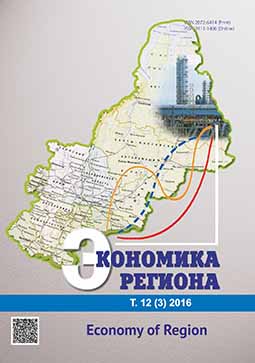Городские агломерации в региональном развитии: теоретические, методические и прикладные аспекты
Urban Agglomerations in Regional Development: Theoretical, Methodological and Applied Aspects
Author(s): Andrey Vladimirovich Shmidt, Valentina Sergeyevna Antonyuk, Alberto FranciniSubject(s): Economy, Geography, Regional studies
Published by: Институт экономики Уральского отделения Российской академии наук
Keywords: urban agglomeration; spatial concentration of the population and economic activity; agglomerative economy; core and satellites of agglomeration; main characteristics of urban agglomeration;
Summary/Abstract: The article focuses on the analysis of the major process of modern socio-economic development, such as the functioning of urban agglomerations. A short background of the economic literature on this phenomenon is given. There are the traditional (the concentration of urban types of activities, the grouping of urban settlements by the intensive production and labour communications) and modern (cluster theories, theories of network society) conceptions. Two methodological principles of studying the agglomeration are emphasized: the principle of the unity of the spatial concentration of economic activity and the principle of compact living of the population. The positive and negative effects of agglomeration in the economic and social spheres are studied. Therefore, it is concluded that the agglomeration is helpful in the case when it brings the agglomerative economy (the positive benefits from it exceed the additional costs). A methodology for examination the urban agglomeration and its role in the regional development is offered. The approbation of this methodology on the example of Chelyabinsk and Chelyabinsk region has allowed to carry out the comparative analysis of the regional centre and the whole region by the main socio-economic indexes under static and dynamic conditions, to draw the conclusions on a position of the city and the region based on such socio-economic indexes as an average monthly nominal accrued wage, the cost of fixed assets, the investments into fixed capital, new housing supply, a retail turnover, the volume of self-produced shipped goods, the works and services performed in the region. In the study, the analysis of a launching site of the Chelyabinsk agglomeration is carried out. It has revealed the following main characteristics of the core of the agglomeration in Chelyabinsk (structure feature, population, level of centralization of the core) as well as the Chelyabinsk agglomeration in general (coefficient of agglomeration, index of agglomeration, coefficient of the development of the population, growth rates of agglomeration). The analysis of the internal environment of the agglomeration has shown that the industry of the majority of the cities-satellites is unprofitable; the space of the urban agglomeration is very heterogeneous. The research proves that the creation of the agglomeration will allow to solve the problems of the production diversification at the territory, to perform the effective land use, to optimize transport and housing-and-municipal infrastructure.
Journal: Экономика региона
- Issue Year: 12/2016
- Issue No: 3
- Page Range: 776 - 789
- Page Count: 14
- Language: Russian

